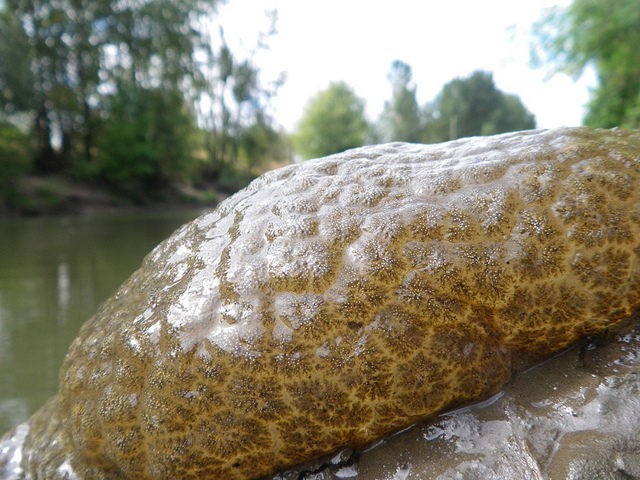Low water levels revealed the strange jelly creatures at Stanley Park in Vancouver, British Columbia.
Within Stanley Park’s “Lost Lagoon,” a strange amorphous blob of life has appeared. The gelatinous “brain” is known as the Pectinatella magnifica, or, more commonly, the “magnificent” bryozoan. What appears to be a single alien organism is instead the gelatinous gathering of hundreds of individual bryozoan “zooids.” At a fraction of a millimeter each, it takes a lot of them to form into these oddly cerebral communities.
The gelatinous creatures are hermaphrodites, possessing all requisite reproductive organs within each individual. They spread from their gelatinous communal clumps via “statoblast,” where clumps of cells are detached from a zooid that can reproduce themselves asexually to form another brain-like colony. Fossil records have placed ancestors of the modern bryozoan as far back as 470 million years, but they have never been spotted outside of areas east of the Mississippi River.
Their unique life cycle and method of sustenance mark them as a potentially “invasive” species. Because they sustain themselves on algae in nutrient-rich water, their proliferation could very well mean starving out other local organisms vital to a region’s ecosystem.
It is difficult to pinpoint exactly why the bryozoan has begun to spread northward, or if it even has. In a 2012 report from the U.S. Fish and Wildlife Service, it was suggested that a warming climate could be to blame for their northward migration.
Stanley Park Ecology Society’s Celina Starnes is skeptical, however. She “[doubts] this is the first time” that the strange creatures have been this far north. First, because they are so easily confused for clusters of salamander eggs or rocks. Their naturally muddy color also makes it exceptionally easy for them to escape notice altogether.
University of British Columbia Biology Professor Ian Walker tends to agree, though the research is far from comprehensive. While he understandably hesitated to pass a final verdict on the bryozoan presence in Stanley Park, he noted that other bryozoans have been spotted in the Okanagan Valley, west of Vancouver.
According to Walker, “it’s something that could have been easily overlooked in the past.” Further, Walker theorizes that “we’re near the northern limit of them. With a warming climate, they might migrate somewhere farther north. I can only really speculate how they might have spread.”
If nothing else, at least we have finally located a known surplus of brains. Whether it will be enough to account for the seeming worldwide shortage remains to be seen.
Follow Nate Church @Get2Church on Twitter for the latest news in gaming and technology, and snarky opinions on both.

COMMENTS
Please let us know if you're having issues with commenting.